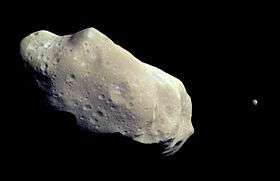Planetary-mass moon
A planetary-mass moon is a planetary-mass object that is also a natural satellite. They are large and ellipsoidal (sometimes spherical) in shape. Two moons in the Solar System are larger than the planet Mercury (though less massive): Ganymede and Titan, and seven are larger and more massive than the dwarf planet Pluto.
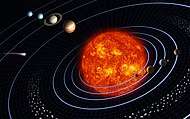 |
| Objects |
|---|
| Lists |
| Planets |
|
|
The concept of satellite planets – the idea that planetary-mass objects, including planetary-mass moons, are planets – is used by some planetary scientists, such as Alan Stern, who are more concerned with whether a celestial body has planetary geology (that is, whether it is a planetary body) than where it orbits (planetary dynamics).[1] This conceptualization of planets as three classes of objects (classical planets, dwarf planets and satellite planets) has not been accepted by the International Astronomical Union (the IAU). In addition, the IAU definition of 'hydrostatic equilibrium' is quite restrictive – that the object's mass be sufficient for gravity to overcome rigid-body forces to become plastic – whereas planetary-mass moons may be in hydrostatic equilibrium due to tidal or radiogenic heating, in some cases forming a subsurface ocean.
Early history
The distinction between a satellite and a classical planet was not recognized until after the heliocentric model of the Solar System was established. When in 1610 Galileo discovered the first satellites of another planet (the four Galilean moons of Jupiter), he referred to them as "four planets flying around the star of Jupiter at unequal intervals and periods with wonderful swiftness."[2] Similarly, Christiaan Huygens, upon discovering Saturn's largest moon Titan in 1655, employed the terms "planeta" (planet), "stella" (star), "luna" (moon), and the more modern "satellite" (attendant) to describe it.[3] Giovanni Cassini, in announcing his discovery of Saturn's moons Iapetus and Rhea in 1671 and 1672, described them as Nouvelles Planetes autour de Saturne ("New planets around Saturn").[4] However, when the Journal de Scavans reported Cassini's discovery of two new Saturnian moons in 1686, it referred to them strictly as "satellites", though sometimes to Saturn as the "primary planet".[5] When William Herschel announced his discovery of two objects in orbit around Uranus in 1787, he referred to them as "satellites" and "secondary planets".[6] All subsequent reports of natural satellite discoveries used the term "satellite" exclusively,[7] though the 1868 book Smith's Illustrated Astronomy referred to satellites as "secondary planets".[8]
Modern concept
In the modern era, Alan Stern considers satellite planets to be one of three categories of planet, along with dwarf planets and classical planets.[9] The term planemo ("planetary-mass object") covers all three populations.[10] Both Stern's and the IAU's definition of 'planet' depends on hydrostatic equilibrium – on the mass of the body being sufficient to render it plastic, so that it relaxes into an ellipsoid under its own gravity. The IAU definition specifies that the mass be great enough to overcome 'rigid-body forces', and it does not address objects that may be in hydrostatic equilibrium due to a subsurface ocean or (in the case of Io) due to magma caused by tidal heating. It is possible that all the larger icy moons have subsurface oceans.[11]
The two moons larger than Mercury have less than half its mass, and it is mass, along with composition and internal temperature, that determine whether a body is plastic enough to be in hydrostatic equilibrium. However, there are seven large moons that are more massive than the dwarf planets Eris and Pluto, which are universally believed (though not yet actually demonstrated) to be in equilibrium. These seven are Earth's Moon, the four Galilean moons of Jupiter (Io, Europa, Ganymede and Callisto), and the largest moons of Saturn (Titan) and of Neptune (Triton). All of these moons are ellipsoidal in shape. Another dozen moons are ellipsoidal as well, indicating that they achieved equilibrium at some point in their histories. However, it has been shown that some of these moons are no longer in equilibrium, due to them becoming increasingly rigid as they cooled over time.
Current equilibrium moons
Determining whether a moon is currently in hydrostatic equilibrium requires close observation, and is easier to disprove than to prove.
Earth's moon, which is entirely rocky, solidified out of equilibrium billions of years ago,[12] but most of the other six moons larger than Pluto, five of which are icy, are assumed to still be in equilibrium. (Ice has less tensile strength than rock, and is deformed at lower pressures and temperatures than rock.) The evidence is perhaps strongest for Ganymede, which has a magnetic field that indicates fluid movement of electrically conducting material in its interior, though whether that fluid is a metallic core or a subsurface ocean is unknown.[13] One of the mid-sized moons of Saturn (Rhea) may also be in equilibrium,[14][11] as may a couple moons of Uranus (Titania and Oberon).[11] However, the other ellipsoidal moons of Saturn (Mimas, Enceladus, Tethys, Dione and Iapetus) are no longer in equilibrium.[14] The situation for Uranus's three smaller ellipsoidal moons (Umbriel, Ariel and Miranda) is unclear, as is that of Pluto's moon Charon.[12] The shapes of Eris's moon Dysnomia, Orcus's moon Vanth and Varda's moon Ilmarë are unknown, but Dysnomia is larger than the three smallest ellipsoidal moons of Saturn and Uranus (Enceladus, Miranda and Mimas), Vanth is larger than Mimas, and Ilmarë is approximately the size of Mimas (within current uncertainties), so they are quite possibly ellipsoidal as well. (Or not. Vanth and Ilmarë may be smaller than Proteus, which is not ellipsoidal.)
List
The moons are evaluated for hydrostatic equilibrium in the general sense, not according to the IAU's narrower use of the term.



| Moon | Image | Radius | Mass | Density | Year of discovery |
Hydrostatic equilibrium? | |||
|---|---|---|---|---|---|---|---|---|---|
| Name | Designation | (km) | (R☾) | (1021 kg) | (M☾) | (g/cm3) | |||
| Ganymede | Jupiter III | 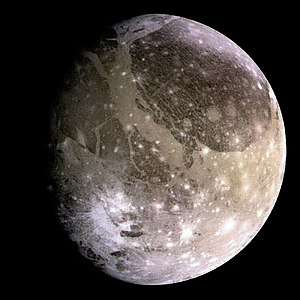 |
2634.1±0.3 | 156.4% | 148.2 | 201.8% | 1.942±0.005 | 1610 | |
| Titan | Saturn VI | 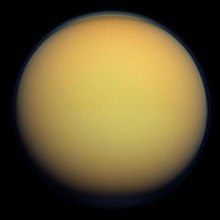 |
2574.7±0.1 | 148.2% | 134.5 | 183.2% | 1.882±0.001 | 1655 | |
| Callisto | Jupiter IV |  |
2410.3±1.5 | 138.8% | 107.6 | 146.6% | 1.834±0.003 | 1610 | |
| Io | Jupiter I | 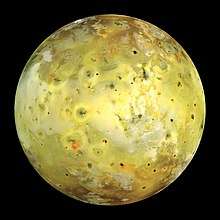 |
1821.6±0.5 | 104.9% | 89.3 | 121.7% | 3.528±0.006 | 1610 | |
| Luna | Earth I | 1737.05 | 100% | 73.4 | 100% | 3.344±0.005 | — | ||
| Europa | Jupiter II |  |
1560.8±0.5 | 89.9% | 48.0 | 65.4% | 3.013±0.005 | 1610 | |
| Triton | Neptune I | .jpg) |
1353.4±0.9 | 79.9% | 21.4 | 29.1% | 2.059±0.005 | 1846 | |
| Titania | Uranus III | _color%2C_edited.jpg) |
788.9±1.8 | 45.4% | 3.40±0.06 | 4.6% | 1.66±0.04 | 1787 | |
| Rhea | Saturn V | 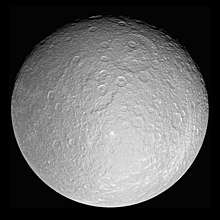 |
764.3±1.0 | 44.0% | 2.31 | 3.1% | 1.233±0.005 | 1672 | |
| Oberon | Uranus IV | 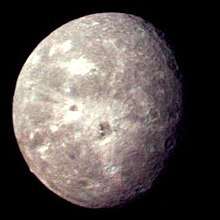 |
761.4±2.6 | 43.8% | 3.08±0.09 | 4.2% | 1.56±0.06 | 1787 | |
| Iapetus | Saturn VIII | 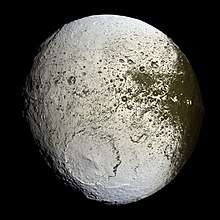 |
735.6±1.5 | 42.3% | 1.81 | 2.5% | 1.083±0.007 | 1671 | |
| Charon | Pluto I | 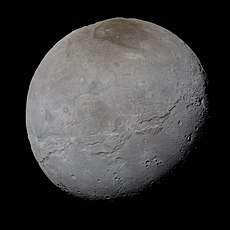 |
603.6±1.4 | 34.7% | 1.53 | 2.1% | 1.664±0.012 | 1978 | |
| Umbriel | Uranus II | 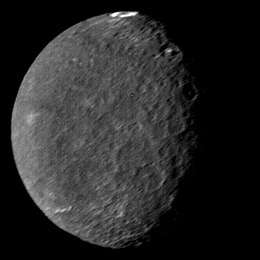 |
584.7±2.8 | 33.7% | 1.28±0.03 | 1.7% | 1.46±0.09 | 1851 | |
| Ariel | Uranus I | .jpg) |
578.9±0.6 | 33.3% | 1.25±0.02 | 1.7% | 1.59±0.09 | 1851 | |
| Dione | Saturn IV | 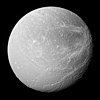 |
561.4±0.4 | 32.3% | 1.10 | 1.5% | 1.476±0.004 | 1684 | |
| Tethys | Saturn III |  |
533.0±0.7 | 30.7% | 0.617 | 0.84% | 0.973±0.004 | 1684 | |
| Dysnomia | Eris I | 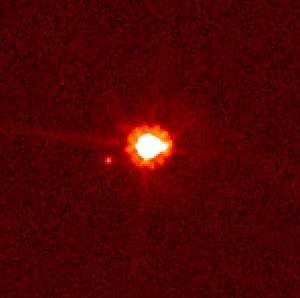 |
350±58 | 20.1% ± 3.3% | < 0.44[17] | < 0.6% | 2005 | ||
| Enceladus | Saturn II |  |
252.1±0.2 | 14.5% | 0.108 | 0.15% | 1.608±0.003 | 1789 | |
| Miranda | Uranus V |  |
235.8±0.7 | 13.6% | 0.064±0.003 | 0.09% | 1.21±0.11 | 1948 | |
| Vanth | Orcus I |  |
221±5 | 12.7% ± 0.3% | 0.02 ~ 0.06 | 0.03% ~ 0.08% | ≈0.8 | 2005? | |
| Mimas | Saturn I | 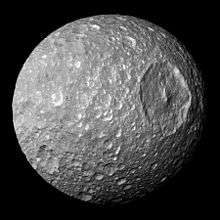 |
198.2±0.4 | 11.4% | 0.038 | 0.05% | 1.150±0.004 | 1789 | |
| Ilmarë | Varda I |  |
163+19 −17[18] |
10.4% ± 1.2% | ca. 0.02?[19] | ca. 0.03% | 1.24+0.50 −0.35 (for system) |
2009 | |
References
- "Should Large Moons Be Called 'Satellite Planets'?". News.discovery.com. 2010-05-14. Archived from the original on 2014-10-25.
- Galileo Galilei (1989). Siderius Nuncius. Albert van Helden. University of Chicago Press. p. 26.
- Christiani Hugenii (Christiaan Huygens) (1659). Systema Saturnium: Sive de Causis Miradorum Saturni Phaenomenon, et comite ejus Planeta Novo. Adriani Vlacq. pp. 1–50.
- Giovanni Cassini (1673). Decouverte de deux Nouvelles Planetes autour de Saturne. Sabastien Mabre-Craniusy. pp. 6–14.
- Cassini, G. D. (1686–1692). "An Extract of the Journal Des Scavans. Of April 22 st. N. 1686. Giving an Account of Two New Satellites of Saturn, Discovered Lately by Mr. Cassini at the Royal Observatory at Paris". Philosophical Transactions of the Royal Society of London. 16 (179–191): 79–85. Bibcode:1686RSPT...16...79C. doi:10.1098/rstl.1686.0013. JSTOR 101844.CS1 maint: ref=harv (link)
- William Herschel (1787). An Account of the Discovery of Two Satellites Around the Georgian Planet. Read at the Royal Society. J. Nichols. pp. 1–4.
- See primary citations in Timeline of discovery of Solar System planets and their moons
- Smith, Asa (1868). Smith's Illustrated Astronomy. Nichols & Hall. p. 23.
secondary planet Herschel.
- "Should Large Moons Be Called 'Satellite Planets'?". News.discovery.com. May 14, 2010. Retrieved November 4, 2011.
- Basri, G.; Brown, M.E. (2006). "Planetesimals to Brown Dwarfs: What is a Planet?" (PDF). Annual Review of Earth and Planetary Sciences. 34: 193–216. arXiv:astro-ph/0608417. Bibcode:2006AREPS..34..193B. doi:10.1146/annurev.earth.34.031405.125058. Archived from the original (PDF) on July 31, 2013.
- Hussmann, Hauke; Sohl, Frank; Spohn, Tilman (November 2006). "Subsurface oceans and deep interiors of medium-sized outer planet satellites and large trans-neptunian objects". Icarus. 185 (1): 258–273. Bibcode:2006Icar..185..258H. doi:10.1016/j.icarus.2006.06.005.
- Nimmo, Francis; et al. (2017). "Mean radius and shape of Pluto and Charon from New Horizons images". Icarus. 287: 12–29. arXiv:1603.00821. Bibcode:2017Icar..287...12N. doi:10.1016/j.icarus.2016.06.027.
- Planetary Science Decadal Survey Community White Paper, Ganymede science questions and future exploration
- P.C. Thomas (2010) 'Sizes, shapes, and derived properties of the saturnian satellites after the Cassini nominal mission', Icarus 208: 395–401
- Most figures are from the NASA/JPL list of Planetary Satellite Physical Parameters, apart from the masses of the Uranian moons, which are from Jacobson (2014), and the Ilmare data.
- Castillo-Rogez, J. C.; et al. (2011). "How differentiated is Callisto" (PDF). 42nd Lunar and Planetary Science Conference: 2580. Retrieved 2 January 2020.
- 0.44×1021 kg if Eris and Dysnomia have the same density of 2.52 g/cm3
- Grundy, W.M.; Porter, S.B.; Benecchi, S.D.; Roe, H.G.; Noll, K.S.; Trujillo, C.A.; Thirouin, A.; Stansberry, J.A.; Barker, E.; Levison, H.F. (2015). "The mutual orbit, mass, and density of the large transneptunian binary system Varda and Ilmarë". Icarus. 257: 130–138. arXiv:1505.00510. Bibcode:2015Icar..257..130G. doi:10.1016/j.icarus.2015.04.036.
- Calculated at 0.02246x10^21 kg on the assumption that Varda and Ilmarë have the same density

